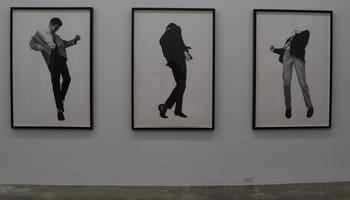Robert Longo Parodies Himself
Robert Longo is the king of that detached world of 80s über-cool, though in retrospect the whole “movement” (if we can call it that) was nothing like its PR. Sure, one could be fooled into thinking that Longo’s corporate figures writhing out of control were comments on the culture of the time, perha

Something just gotta die for new things to take root and one of those things seems to be a certain sense of 1980s cool that never left New York and continues to influence artists to make hollow parodies of corporatism as if commenting on it was enough.
Robert Longo is the king of that detached world of 80s über-cool, though in retrospect the whole “movement” (if we can call it that) was nothing like its PR. Sure, one could be fooled into thinking that Longo’s corporate figures writhing out of control were comments on the culture of the time, perhaps even foreboding what was to come — Reaganomics, corporate avarice, an extreme form of alienation — but did we really think it would lead to advertisements for Bottega Veneta?

Recently, the 1980s art star has been hired to Bottega Veneta to creative an ad campaign and I can’t think of a more effective way for Longo to have hollowed out any profound meaning to his iconic works than to make them into mannequins for a luxury brand. What is he thinking? Can a campaign like this do anything but destroy any formative meaning to the works. At the end of day art does involve a manner of style and artists are welcome to sell-out to anyone but Longo’s series seems to take a swipe at his original series.
Longo isn’t the only one shilling for Bottega Veneta, Nan Goldin is doing the same, and while her works are a far cry from the marginal subjects that made her famous, she did have the good judgment not to directly quote from her most famous work. Yet Longo, who has never done an ad campaign before, chose to do this one? According to an interview in W Magazine he says the reason is partly the iPod:
But ever since Apple launched its iPod ads featuring silhouetted hipsters jumping around, he has felt a twinge of envy (mixed, he admits, with irritation) toward what he sees as the appropriation of his seminal Eighties work.
Longo seems honored to have been asked to pimp the brand:
“He said something to the effect of ‘Instead of ripping you off, we want to hire you,’” Longo says. “They got me at hello.”
I personally don’t really see the similarities between the iPod ads and the Men in Cities series that Longo sees. In my opinion, the Apple ads seem to refer as much to the writhing figures of the Renaissance or Baroque — which Longo was undoubtedly referencing in his original series, think Bernini’s “Ecstasy of Saint Teresa” (1647-52) — and the Apple ads involve more positive feelings like joy or excitement. Longo’s silhouetted figures, on the other hand, are more fixated on darker emotions like pain, confusion, and seem often on the verge of collapes. Even those Longo figures that tend towards ecstacy and serenity seem tinged with something more sobering.
Regardless, if it’s possible to diminish a great art series than Longo has found a way. I hope he really needed to money, because otherwise I don’t see the reason why he did this. Ego, perhaps?





